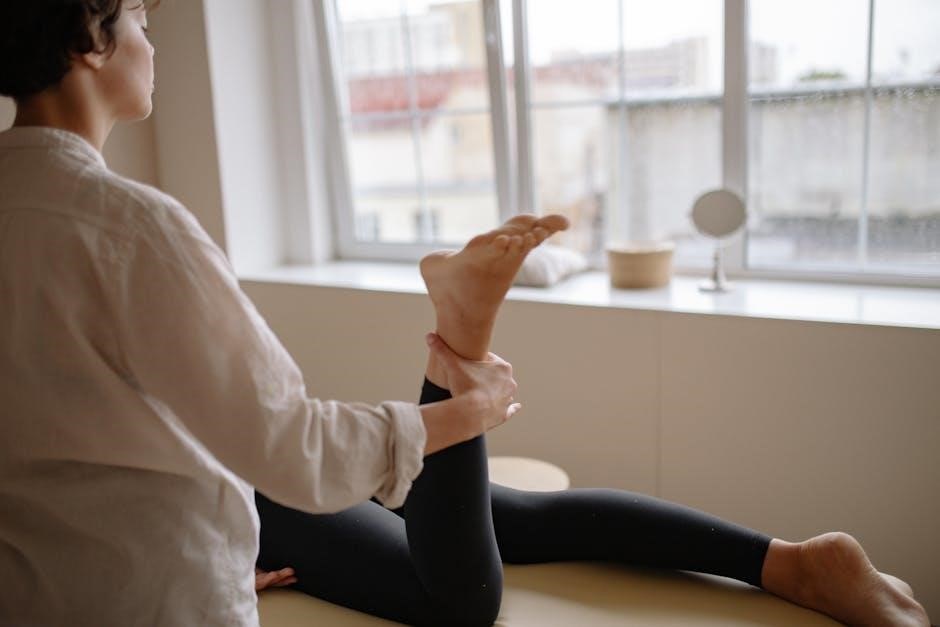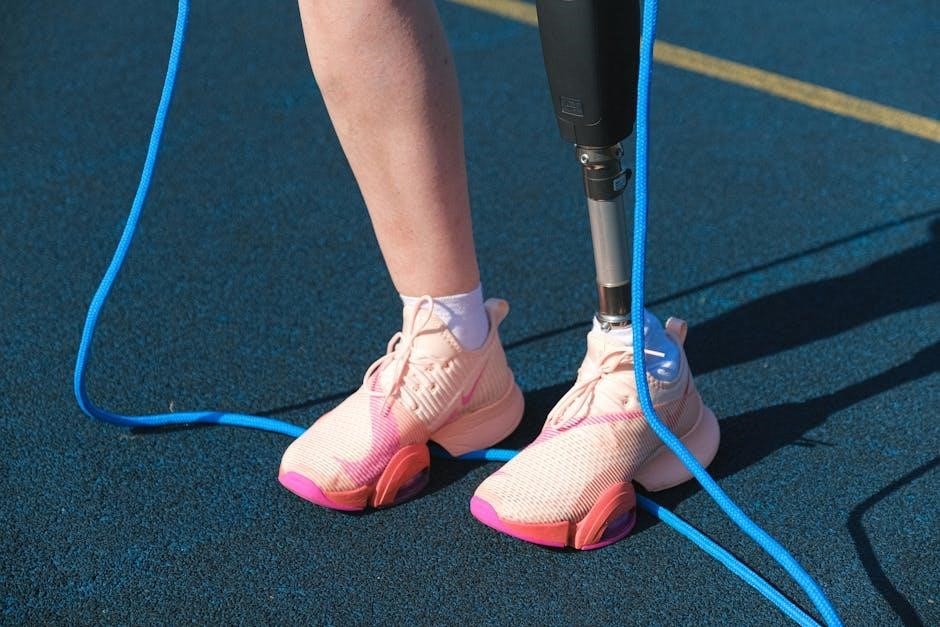The thoracic spine, located between the cervical and lumbar regions, plays a crucial role in posture, movement, and respiratory function. Maintaining its mobility is essential for preventing stiffness and enhancing overall spinal health, particularly in sedentary populations.
What is Thoracic Spine Mobility?
Thoracic spine mobility refers to the range of motion in the mid-back region, enabling rotation, extension, and flexion. It is essential for maintaining proper posture, facilitating movement, and supporting respiratory function. Limited mobility in this area can lead to stiffness, poor posture, and restricted breathing. Exercises targeting thoracic spine mobility aim to enhance flexibility and strength, improving overall spinal health and reducing the risk of discomfort or injury. Regular practice ensures optimal movement and prevents issues like mid-back pain and poor alignment, which can interfere with daily activities and athletic performance.
Why is Thoracic Spine Mobility Important?
Thoracic spine mobility is vital for maintaining proper posture, facilitating smooth movement, and supporting respiratory function. It enables the mid-back to rotate, extend, and flex, which are essential for everyday activities and athletic performance. Limited mobility can lead to poor posture, mid-back pain, and restricted breathing. Additionally, it can contribute to shoulder and neck tension, as other areas compensate for the lack of motion. Improving thoracic spine mobility enhances overall spinal health, reduces injury risk, and promotes better alignment, making it a cornerstone of fitness and wellness routines for individuals of all activity levels.

Benefits of Thoracic Spine Mobility Exercises
Regular thoracic spine exercises improve posture, enhance athletic performance, and reduce mid-back pain. They also promote better breathing and overall spinal flexibility, essential for long-term health.
Improved Posture
Thoracic spine mobility exercises significantly enhance posture by addressing mid-back stiffness and muscle imbalances. Improved mobility allows for better alignment of the spine, reducing slouching and hunched shoulders. Strengthening the abdominals and latissimus dorsi muscles through these exercises helps maintain a neutral spine position. Additionally, increased flexibility in the thoracic region promotes proper shoulder mechanics, further supporting upright posture. Regular practice of exercises like the Wall Angel or Child’s Pose can lead to long-term postural improvements, reducing the risk of back pain and enhancing overall spinal health. Consistency in these exercises ensures a more balanced and upright posture in daily activities.
Enhanced Athletic Performance
Thoracic spine mobility is crucial for athletes, as it directly impacts movement efficiency and power. Improved mobility enhances rotational movements, essential for sports like golf, tennis, and baseball. Better thoracic flexibility reduces energy expenditure during activities, allowing for more efficient energy use. Strengthened mid-back muscles improve stability, reducing injury risk and boosting overall performance. Exercises like rotational stretches and thoracic extensions are particularly beneficial, enabling athletes to maintain proper form and generate force effectively. Enhanced thoracic mobility also improves breathing, providing a competitive edge in endurance sports. Regular practice of these exercises can lead to significant advancements in athletic capabilities and overall performance.
Reduced Mid-Back Pain and Stiffness
Improved thoracic spine mobility significantly reduces mid-back pain and stiffness by enhancing flexibility and relieving tension in the upper body. Exercises like thoracic rotations and child’s pose target the mid-back, releasing tight muscles and improving joint movement. Better mobility also promotes proper posture, reducing strain on the thoracic region. Strengthening the surrounding muscles through targeted exercises helps stabilize the spine, further alleviating discomfort. Regular practice of these exercises can lead to long-term relief from mid-back pain, enhancing overall comfort and movement quality for everyday activities and athletic performance alike. Consistency is key to maintaining these benefits and preventing stiffness.
Better Breathing and Respiratory Function
Thoracic spine mobility exercises significantly enhance breathing and respiratory function by improving the range of motion in the upper back. A mobile thoracic spine allows the ribcage to expand more effectively, increasing lung capacity and promoting deeper, more efficient breathing. This is particularly beneficial for athletes and individuals with respiratory conditions, as it enhances oxygen intake. Additionally, improved posture from thoracic mobility reduces compression on the diaphragm, further optimizing breath quality. Regular practice of exercises like wall angels and seated twists can lead to better respiratory function, improving overall health and physical performance.

Causes of Limited Thoracic Spine Mobility
Limited thoracic spine mobility is often due to sedentary lifestyles, poor posture, muscle imbalances, tightness, or previous injuries. These factors restrict movement, leading to stiffness and discomfort.
Sedentary Lifestyles and Poor Posture
Sedentary lifestyles and poor posture are primary contributors to limited thoracic spine mobility. Prolonged sitting often leads to a rounded upper back, causing the thoracic spine to become stiff and immobile. This can result in muscle imbalances, where some muscles become overly tight while others weaken. Poor posture, such as slouching or forward-leaning positions, further exacerbates this issue, reducing the spine’s natural range of motion. Over time, these habits can lead to chronic discomfort and impaired movement, making it essential to address them through targeted exercises and postural awareness to restore thoracic spine mobility and overall spinal health.
Muscle Imbalances and Tightness
Muscle imbalances and tightness significantly impact thoracic spine mobility. Tightness in the chest muscles (pectorals) and latissimus dorsi can pull the spine into a flexed position, reducing its ability to extend and rotate. Conversely, weakness in the upper back muscles (rhomboids and trapezius) can lead to poor posture and limited movement. These imbalances often result from repetitive activities, such as forward-reaching motions or excessive sitting, which overactivate certain muscles while underactivating others. Addressing these imbalances through targeted stretching and strengthening exercises is crucial for restoring thoracic spine mobility and promoting overall spinal health and functionality.
Previous Injuries or Trauma
Previous injuries or trauma to the thoracic spine can significantly limit its mobility. Events like vertebral fractures, herniated discs, or muscle strains create scar tissue, leading to stiffness and reduced flexibility. Post-surgical scars or chronic inflammation from past injuries further restrict movement. Additionally, trauma can cause compensatory patterns, where nearby muscles tighten to protect the injured area, perpetuating limited mobility. Addressing these issues requires gentle, targeted exercises to regain range of motion without exacerbating damage. Physical therapy and careful progression are essential to restore thoracic spine function and prevent long-term immobilization.

Assessing Thoracic Spine Mobility
Evaluating thoracic spine mobility involves specific tests like the thoracic rotation and extension assessments to identify limitations in movement and flexibility, guiding targeted exercise programs.
Thoracic Rotation Test
The thoracic rotation test assesses rotational mobility by measuring how far the trunk can turn. Stand tall, feet shoulder-width apart, arms extended. Rotate torso to one side, keeping hips stable, and note the angle achieved. Limited rotation may indicate stiffness or muscle imbalances. This test helps identify asymmetries and guides corrective exercises. Proper posture and engagement of core muscles are crucial for accurate results. Regular assessment can track progress and ensure exercises are effective in improving mobility. Consistency in testing allows for tailored adjustments to enhance thoracic spine flexibility and overall movement patterns.
Thoracic Extension Assessment
The thoracic extension assessment evaluates the spine’s ability to extend backward. Lie prone with arms extended overhead. Slowly lift arms, shoulders, and upper back off the ground while keeping hips and legs relaxed. The range of motion achieved indicates thoracic flexibility. Limited extension may suggest stiffness or muscle tightness. This test helps identify restrictions in the mid-back, which can contribute to poor posture or breathing difficulties. Regular assessment allows for tracking progress and refining exercises to improve thoracic spine mobility, ensuring better overall spinal function and reducing the risk of discomfort or injury.
Seated Thoracic Rotation Test
The seated thoracic rotation test evaluates rotational mobility in the mid-back. Sit tall with feet flat, hands behind head, and elbows wide. Slowly rotate torso to one side, keeping hips facing forward. Measure the range of motion and note any asymmetry or discomfort. This test identifies restrictions in thoracic rotation, which can impact posture, breathing, and athletic performance. Limited rotation may indicate stiffness or muscle imbalances. Regular assessment helps track progress and refine exercises to enhance thoracic spine mobility, promoting better movement and reducing injury risk. Consistency in testing ensures accurate monitoring of improvements over time.

Basic Thoracic Spine Mobility Exercises
Begin with simple exercises like the Wall Angel to improve extension and rotation. Thoracic Spine Rotations and Child’s Pose with extension also enhance flexibility and reduce stiffness naturally.
Wall Angel Exercise
The Wall Angel exercise targets thoracic spine mobility by improving extension and reducing stiffness. Stand in a doorway with arms on the doorframe at shoulder height. Lean forward, keeping arms straight, to stretch the chest and upper back. Hold for 30 seconds. This exercise enhances posture, reduces mid-back pain, and improves breathing. Regular practice promotes flexibility and spinal health. Ideal for sedentary individuals and athletes alike, it’s a simple yet effective stretch for daily routines.
Thoracic Spine Rotations
Thoracic spine rotations are a dynamic stretch that enhances rotational mobility. Start on all fours with hands under shoulders and knees under hips. Rotate your torso to the right, bringing your right shoulder toward your left hip, while keeping your hips stable. Hold for a breath, then return. Repeat on the left. This exercise improves flexibility, reduces stiffness, and enhances movement quality. Regular practice can alleviate mid-back pain and improve athletic performance. It’s effective for individuals with sedentary lifestyles or those seeking to optimize spinal health and overall mobility.
Child’s Pose with Thoracic Extension
Child’s Pose with Thoracic Extension is a simple yet effective stretch to improve mid-back flexibility. Start on your knees, sit back onto your heels, and stretch your arms forward. Lower your chest toward the floor, arching your upper back to target the thoracic spine. Hold for 30 seconds, breathing deeply. For added intensity, place your hands on a foam roller to deepen the stretch. This exercise is ideal for addressing stiffness and improving posture. It’s particularly beneficial for office workers and athletes to relieve mid-back tension and enhance spinal mobility, making it a versatile addition to any routine.
Kneeling Thoracic Stretch
The Kneeling Thoracic Stretch targets the mid-back region to improve flexibility and reduce stiffness. Begin on all fours, then slide your right hand forward and across your left arm, lowering your right shoulder toward the ground. This movement stretches the thoracic spine and can be intensified with a resistance band. Hold for 10 seconds, repeat 10 times on each side. This exercise is beneficial for athletes and individuals with limited mobility, enhancing rotational movement and posture. Regular practice helps maintain spinal health and prevents mid-back discomfort, making it a valuable addition to daily mobility routines.
Seated Thoracic Twist
The Seated Thoracic Twist is an effective exercise for improving spinal rotation and reducing stiffness. Sit with a PVC pipe or resistance band across your upper back, knees slightly bent, and feet flat on the floor. Rotate your torso to one side, maintaining upright posture, and hold for 5 deep breaths. Repeat on the other side. This exercise enhances thoracic mobility, improves posture, and reduces mid-back tension. It is particularly beneficial for office workers and athletes, promoting better movement patterns and reducing injury risk. Consistent practice helps maintain flexibility and supports overall spinal health.

Advanced Thoracic Spine Mobility Exercises
Advanced exercises target enhanced flexibility and strength for experienced practitioners. Techniques like resistance band rotations, weighted extensions, and dynamic stretching improve thoracic spine mobility, reducing stiffness and improving posture.
Using a Resistance Band for Assisted Rotation
Using a resistance band for assisted thoracic rotation enhances mobility by providing gentle support and tension. Anchor the band at shoulder height and hold it with both hands. Sit back slightly, engaging your core, and rotate your torso against the band’s resistance. Focus on slow, controlled movements to maximize stretch and improve rotational range. This exercise is particularly effective for addressing stiffness and asymmetry in thoracic rotation. Perform 3 sets of 10-12 repetitions on each side, adjusting resistance as needed. It’s an excellent tool for both rehabilitation and advanced mobility training, promoting better posture and reducing mid-back tension.
Weighted Thoracic Spine Extension
Weighted thoracic spine extension strengthens the muscles of the mid-back while improving flexibility. Lie on your stomach with arms extended overhead. Slowly lift your chest and arms off the ground, holding a light weight or resistance band. Focus on squeezing your shoulder blades together and extending your thoracic spine. Hold for 2-3 seconds, then lower slowly. Perform 3 sets of 12-15 repetitions. This exercise enhances posture, reduces stiffness, and improves respiratory function. Gradually increase the weight as mobility and strength improve. Ensure controlled movements to avoid strain and maintain proper breathing techniques throughout the exercise.
Thoracic Spine Mobilization with a Foam Roller
Thoracic spine mobilization with a foam roller is an effective way to release tension and improve mid-back flexibility. Place the foam roller perpendicular to your spine at the mid-back level. Lie on it, knees bent and feet flat, with hands behind your head for support. Slowly roll up and down, focusing on areas of tightness. Breathe deeply, exhaling as you apply pressure. Spend 30 seconds to a minute on each segment. Avoid direct pressure on the spine; instead, target the surrounding muscles. This technique enhances blood flow, reduces stiffness, and promotes better spinal movement. Use consistent, controlled motions for optimal results.
Dynamic Thoracic Spine Stretching
Dynamic thoracic spine stretching involves active movements to enhance flexibility and mobility. Start with controlled rotations: sit tall, place hands behind your head, and gently twist your torso side to side. Incorporate extension stretches by interlacing fingers and arching your mid-back. Use a foam roller or resistance band for assisted movements. Dynamic stretches improve posture, reduce stiffness, and enhance respiratory function. Begin slowly, gradually increasing range and intensity. These exercises are ideal for warming up or cooling down, promoting better spinal movement and overall thoracic spine health. Regular practice can significantly reduce mid-back discomfort and improve athletic performance.

Thoracic Spine Mobility Exercises for Specific Needs
- Office Workers: Chair rotations and desk stretches to counteract sedentary postures.
- Athletes: Dynamic twists and resistance band exercises for enhanced performance.
Exercises for Office Workers
Office workers often suffer from thoracic spine stiffness due to prolonged sitting. Simple yet effective exercises can be done at a desk to improve mobility. Seated thoracic rotations involve turning the torso while keeping the pelvis still, holding for 20-30 seconds per side. Chest stretches against a wall or doorframe help reduce forward leaning. The cat-cow stretch, performed in a chair, gently mobilizes the spine. Desk pushaways and shoulder blade squeezes also enhance posture and reduce tension. Incorporating these exercises every 30-60 minutes can significantly improve thoracic mobility and reduce the risk of mid-back pain. Consistency is key for long-term benefits.
Exercises for Athletes
Athletes benefit from advanced thoracic spine mobility exercises to enhance performance and prevent injuries. Using a resistance band for assisted rotation strengthens rotational movement, improving sports-specific actions like throwing or swinging. Dynamic stretching, such as rotational lunges, increases flexibility during warm-ups. Weighted thoracic extensions with light dumbbells or a barbell strengthen the muscles around the spine, promoting better stability and power. Incorporating these exercises into training routines can improve range of motion, reduce stiffness, and support overall athletic performance. Consistency and proper form are crucial for maximizing benefits and maintaining spinal health.
Exercises for Seniors
Seniors can benefit from gentle thoracic spine mobility exercises to improve flexibility and reduce stiffness. The wall angel exercise, performed standing with arms on a wall, helps restore extension and posture. Seated thoracic twists, using a chair for support, promote rotational movement safely. Child’s Pose with thoracic extension stretches the mid-back while being easy on the joints. Breathing deeply during these exercises enhances relaxation and mobility. Using props like foam rollers or resistance bands can assist in achieving a deeper stretch without strain. Regular practice improves posture, reduces mid-back pain, and enhances overall mobility, making daily activities easier and more comfortable.

Best Practices for Performing Thoracic Spine Exercises
Proper breathing, core engagement, and controlled movements are essential for effective thoracic spine exercises. Use props like foam rollers or bands to enhance stretches safely and maintain form throughout each exercise to maximize benefits and prevent injury.
Proper Breathing Techniques
Proper breathing is vital during thoracic spine exercises to ensure safety and effectiveness. Practice diaphragmatic breathing, inhaling deeply through the nose, allowing the abdomen to rise, and exhaling slowly through the mouth. This technique helps stabilize the core and maintain a neutral spine position, reducing strain on the thoracic region. Breathing in sync with movements enhances flexibility and prevents muscle tension. Avoid holding breath, as it increases intra-abdominal pressure and can lead to discomfort or injury. Consistent practice of these techniques will optimize the benefits of thoracic spine mobility exercises and promote overall spinal health.
Maintaining Core Engagement
Maintaining Core Engagement
Maintaining core engagement is essential for effective thoracic spine mobility exercises. A stable core provides a foundation, allowing the thoracic spine to move freely without compensating with other areas. To engage your core, draw your navel toward your spine and maintain a neutral pelvis. This stabilization enhances the effectiveness of exercises like thoracic rotations or extensions. Proper core engagement prevents excessive movement in the lumbar spine and reduces the risk of strain. Activate your core before starting any exercise and sustain it throughout to ensure safe and efficient thoracic spine mobility work.
Using Props for Enhanced Stretch
Using props like foam rollers, resistance bands, or PVC pipes can enhance thoracic spine stretches. A foam roller helps release tension by rolling along the mid-back, improving flexibility. Resistance bands assist in deeper rotations, while PVC pipes provide stability for exercises like the prayer stretch. For advanced mobility, tools like a “peanut” (two taped lacrosse balls) target specific spinal segments. These props help maintain proper form, increase range of motion, and prevent strain. Incorporating them into your routine can deepen stretches and promote better thoracic spine mobility, making exercises more effective and safe.

Case Study: Improving Thoracic Spine Mobility
A client with chronic mid-back stiffness used a peanut mobilization tool, achieving significant improvements in thoracic rotation and reduced pain, enhancing their overall spinal health and mobility.
Success Stories from Individuals
Individuals practicing thoracic spine exercises reported significant improvements. A client with chronic stiffness used a peanut tool, achieving enhanced rotation and reduced pain. Another, incorporating wall angels and rotations, noticed better posture and breathing. Athletes saw boosts in performance and injury prevention, while office workers reduced mid-back discomfort. Seniors experienced increased flexibility and mobility, improving daily activities. These testimonials highlight the transformative impact of consistent thoracic spine mobility practice on overall spinal health and well-being.
Before and After Results
Individuals who consistently practiced thoracic spine mobility exercises experienced remarkable improvements. Before starting, many reported stiffness, limited range of motion, and mid-back pain. Posture was often slouched, breathing shallow, and athletic performance hindered. After incorporating exercises like wall angels, rotations, and child’s pose, participants noted significant reductions in discomfort and enhanced flexibility. Posture improved, breathing became deeper, and spinal mobility increased. Athletic performance saw boosts in strength and endurance. Office workers reported less mid-back tension, while seniors experienced easier daily movements. These measurable changes highlight the transformative benefits of dedicated thoracic spine mobility practice.
Thoracic spine mobility is vital for posture, breathing, and overall well-being. Regular exercises can significantly reduce stiffness and enhance flexibility, benefiting everyone from office workers to athletes.
Summarizing the Importance of Thoracic Spine Mobility
Thoracic spine mobility is essential for maintaining proper posture, facilitating efficient movement, and ensuring optimal respiratory function. It enhances flexibility, reduces mid-back stiffness, and minimizes the risk of injuries during physical activities. Improved mobility also supports better breathing mechanics, as the thoracic spine’s flexibility allows for deeper inhalation. Limited mobility can lead to discomfort, poor posture, and reduced athletic performance. Regular exercises targeting the thoracic spine can significantly improve overall spinal health, making daily tasks and sports easier. Consistent practice is key to maintaining mobility and preventing long-term discomfort or injury.
Encouraging Consistency in Practice
Consistency is vital for improving and maintaining thoracic spine mobility. Regular practice prevents stiffness and enhances flexibility, reducing the risk of injury. Incorporate exercises like wall angels, rotations, and seated twists into daily routines for optimal results. Even brief sessions can yield significant benefits. Tracking progress through assessments helps stay motivated. Over time, consistent practice improves posture, breathing, and overall spinal health, making daily activities and physical performance more efficient and pain-free. Patience and dedication are key to achieving lasting mobility and preventing long-term discomfort.

Additional Resources
- Downloadable PDF guides provide detailed exercises and stretches for improving thoracic spine mobility.
- Recommended reading includes articles on spinal health and videos demonstrating effective techniques.
- Explore expert-led tutorials and comprehensive guides for tailored mobility routines.
Recommended Reading and Videos
Enhance your knowledge with comprehensive guides and tutorials on thoracic spine mobility. Websites like Squat University offer detailed articles and videos on exercises and stretches. YouTube channels such as Dr. Eric Goodman provide expert-led tutorials for improving mid-back flexibility. Videos often demonstrate techniques like thoracic rotations, extensions, and twists. Additionally, downloadable PDFs and e-books outline step-by-step routines for all fitness levels. These resources cover posture correction, injury prevention, and advanced mobility drills. They are perfect for athletes, office workers, and seniors seeking tailored approaches to spinal health.
Downloadable PDF Guides for Thoracic Spine Mobility
Downloadable PDF guides provide structured plans for improving thoracic spine mobility. These guides often include step-by-step exercises like wall angels, thoracic rotations, and extensions. Many resources cater to specific needs, such as office workers, athletes, and seniors. Websites like Squat University and fitness platforms offer free and premium PDFs with visual instructions and progress tracking. These guides emphasize consistency, proper technique, and gradual improvement. They are ideal for creating a personalized routine to enhance posture, reduce stiffness, and boost overall spinal health. Printable charts and workout schedules make it easy to stay consistent with daily mobility practices.

No Responses